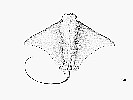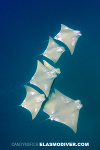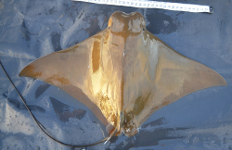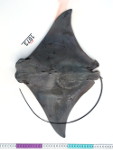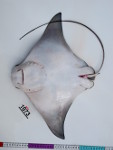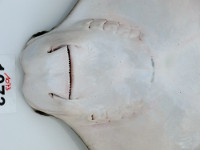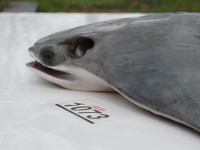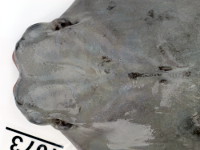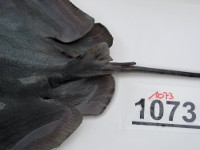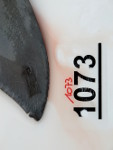Rhinoptera bonasus
(Mitchill, 1815)
Cownose ray
Classification: Elasmobranchii Myliobatiformes Rhinopteridae
Reference of the original description
The fishes of New York described and arranged. Transactions of the Literary and Philosophical Society of New York, 1, 355–492
The fishes of New York described and arranged. Transactions of the Literary and Philosophical Society of New York, 1, 355–492
Image of the original description
No image in first description.
No image in first description.
Synonyms / new combinations and misspellings
Raja bonasus, Raja quadriloba, Rhinoptera aff. bonasus, Rhinoptera affinis, Rhinoptera cf. bonasus, Rhinoptera lalandi, Rhinoptera lalandii, Rhinoptera quadriloba
Raja bonasus, Raja quadriloba, Rhinoptera aff. bonasus, Rhinoptera affinis, Rhinoptera cf. bonasus, Rhinoptera lalandi, Rhinoptera lalandii, Rhinoptera quadriloba
Types
Rhinoptera bonasus
XXXX: No types known;
Raja quadriloba
XXXX: No types known;
Rhinoptera affinis
Syntype: BMNH: ? 1867.11.28.211 Java RMNH: 7462
Rhinoptera lalandii
Syntype: MNHN: 3475; MNHN: 2606;
Rhinoptera bonasus
XXXX: No types known;
Raja quadriloba
XXXX: No types known;
Rhinoptera affinis
Syntype: BMNH: ? 1867.11.28.211 Java RMNH: 7462
Rhinoptera lalandii
Syntype: MNHN: 3475; MNHN: 2606;
Description :
Citation: Rhinoptera bonasus (Mitchill, 1815): In: Database of modern sharks, rays and chimaeras, www.shark-references.com, World Wide Web electronic publication, Version 12/2025
Please send your images of "Rhinoptera bonasus" to info@shark-references.com
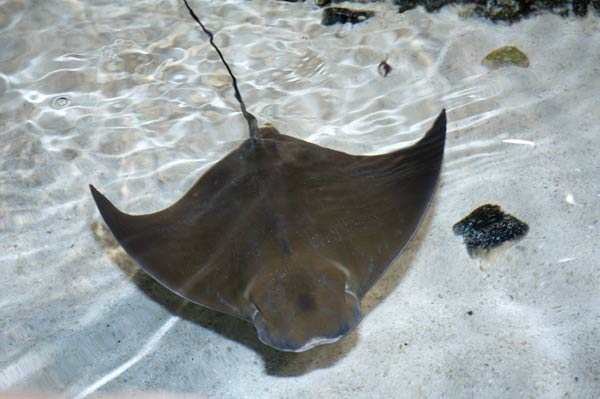
Rhinoptera bonasus (Mitchill, 1815), © Andy Murch Elasmodiver

Rhinoptera bonasus (Mitchill, 1815), © Andy Murch Elasmodiver
Common names
 Cara de vaca,
Cara de vaca,  Chucho,
Chucho,  Chucho marrón,
Chucho marrón,  Chucho mono,
Chucho mono,  Gavilan mancha,
Gavilan mancha,  Gavilan manchado,
Gavilan manchado,  Gavilán cubanito,
Gavilán cubanito,  Mancha,
Mancha,  Raya gavilán,
Raya gavilán,  Mourine américaine,
Mourine américaine,  Cow-nosed ray,
Cow-nosed ray,  Cowfish,
Cowfish,  Cownose Ray,
Cownose Ray,  Cownose rays,
Cownose rays,  Manta,
Manta,  Skeete,
Skeete,  Arraia,
Arraia,  Raia,
Raia,  Raia-focinho-de-vaca,
Raia-focinho-de-vaca,  Raia-sapo,
Raia-sapo,  Raia-ticonha,
Raia-ticonha,  Ticonha
Ticonha
 Cara de vaca,
Cara de vaca,  Chucho,
Chucho,  Chucho marrón,
Chucho marrón,  Chucho mono,
Chucho mono,  Gavilan mancha,
Gavilan mancha,  Gavilan manchado,
Gavilan manchado,  Gavilán cubanito,
Gavilán cubanito,  Mancha,
Mancha,  Raya gavilán,
Raya gavilán,  Mourine américaine,
Mourine américaine,  Cow-nosed ray,
Cow-nosed ray,  Cowfish,
Cowfish,  Cownose Ray,
Cownose Ray,  Cownose rays,
Cownose rays,  Manta,
Manta,  Skeete,
Skeete,  Arraia,
Arraia,  Raia,
Raia,  Raia-focinho-de-vaca,
Raia-focinho-de-vaca,  Raia-sapo,
Raia-sapo,  Raia-ticonha,
Raia-ticonha,  Ticonha
Ticonha
Short Description
Deep grove around front of head below eyes; forehead above groove indented, snout below groove is distinctly bilobed [17659]. Disk brown to olive above, with no spots or marks, wings long and pointed [17658]. Lower surface white or yellowish white [199].
Deep grove around front of head below eyes; forehead above groove indented, snout below groove is distinctly bilobed [17659]. Disk brown to olive above, with no spots or marks, wings long and pointed [17658]. Lower surface white or yellowish white [199].
Distribution
Eastern Atlantic: Mauritania, Senegal and Guinea. Western Atlantic: southern New England to northern Florida (USA) and throughout the Gulf of Mexico, migrating to Trinidad, Venezuela, Brazil and Uruguay [17658]. Source: www.gbif.org
Eastern Atlantic: Mauritania, Senegal and Guinea. Western Atlantic: southern New England to northern Florida (USA) and throughout the Gulf of Mexico, migrating to Trinidad, Venezuela, Brazil and Uruguay [17658]. Source: www.gbif.org
Human uses
fisheries: minor commercial; aquarium: public aquariums; price category: medium; price reliability: very questionable: based on ex-vessel price for species in this family
fisheries: minor commercial; aquarium: public aquariums; price category: medium; price reliability: very questionable: based on ex-vessel price for species in this family
Biology
Exhibit ovoviparity (aplacental viviparity), with embryos feeding initially on yolk, then receiving additional nourishment from the mother by indirect absorption of uterine fluid enriched with mucus, fat or protein through specialised structures [733]. An oceanic species sometimes found near the coast (Ref. 5217). Forms segregated schools [1658]. Jumps occasionally, landing with a loud smack, probably as a territorial display. Migrates south in large schools that disappear off northern Florida, USA and are not reported from Caribbean Is.; tagged fish have been recovered in northern South America [17658]. Population in the Gulf of Mexico migrates clockwise; schools of up to 10,000 rays leave west coast of Florida for Yucatan, Mexico in the fall [17658]. Foraging schools of rays invade tidal flats during the flood tide. Stirring motions of the pectoral fins combined with suction from the expansive orobranchial chamber are probably used to excavate deep burrowing bivalves (Ref. 59106). Adult rays feed on deep burrowing mollusks and juveniles feed on shallow or non-burrowing bivalves (Ref. 59106). The soft shell, Mya arenaria, contributed the greatest frequency of occurrence (Ref. 59106). Exposed pectoral fin tips and water boils on a calm surface was characterized the shallow-water feeding activity of cownose rays (Ref. 59106).
Exhibit ovoviparity (aplacental viviparity), with embryos feeding initially on yolk, then receiving additional nourishment from the mother by indirect absorption of uterine fluid enriched with mucus, fat or protein through specialised structures [733]. An oceanic species sometimes found near the coast (Ref. 5217). Forms segregated schools [1658]. Jumps occasionally, landing with a loud smack, probably as a territorial display. Migrates south in large schools that disappear off northern Florida, USA and are not reported from Caribbean Is.; tagged fish have been recovered in northern South America [17658]. Population in the Gulf of Mexico migrates clockwise; schools of up to 10,000 rays leave west coast of Florida for Yucatan, Mexico in the fall [17658]. Foraging schools of rays invade tidal flats during the flood tide. Stirring motions of the pectoral fins combined with suction from the expansive orobranchial chamber are probably used to excavate deep burrowing bivalves (Ref. 59106). Adult rays feed on deep burrowing mollusks and juveniles feed on shallow or non-burrowing bivalves (Ref. 59106). The soft shell, Mya arenaria, contributed the greatest frequency of occurrence (Ref. 59106). Exposed pectoral fin tips and water boils on a calm surface was characterized the shallow-water feeding activity of cownose rays (Ref. 59106).
Remarks
shark-references Species-ID=6059;
shark-references Species-ID=6059;
Parasites (arranged by Jürgen Pollerspöck)
Conoidasida
Monogenea
Cestoda
Copepoda
Hirudinea
Conoidasida
Monogenea
- Benedeniella posterocolpa (Hargis, 1955) Yamaguti, 1963 [17148] [21292] [17205] [21204] [21222] [23771] [26032] [32700]
- Euzetia lamothei Pulido-Flores & Monks, 2008 [21496] [23771] [26032]
Cestoda
- Caulobothrium longicolle (Linton, 1890) [16247]
- Dioecotaenia campbelli Mayes & Brooks, 1981 [16909] [25154]
- Dioecotaenia cancellata (Linton, 1890) [16178]
- Dioecotaenia sp. [16929]
- Duplicibothrium minutum Williams & Campbell, 1978 [16191] [16929] [16908] [16909]
- Duplicibothrium sp. [16909]
- Eniochobothrium sp. [16909]
- Glyphobothrium zwerneri Williams & Campbell, 1977 [16189] [16929] [23771]
- Halysioncum bonasum (Williams & Campbell, 1980) [7577] [16430] [19536]
- Halysioncum sp. [19536]
- Mecistobothrium brevispine (Linton, 1897) [16184] [16112]
- Nanoduplicibothrium leanneae Stephan, Bueno & Caira, 2023 [32209]
- Nybelinia sp. [16112]
- Rhinoptericola megacantha Carvajal & Campbell, 1975 [7611] [16356] [16112] [15747] [25154] [30611] [32402]
- Rhodobothrium paucitesticulare Mayes & Brooks, 1981 [16356] [16908] [16909] [25154]
- Tylocephalum bonasum Campbell & Williams, 1984 [16276]
- Tylocephalum brooksi Ivanov & Campbell, 2000 [16202] [25154]
- Tylocephalum marsupium Linton, 1916 [16172]
- Tylocephalum pingue Linton, 1890 [16276] [16338]
- Tylocephalum sp. [16356] [23959] [25154]
- Zygorhynchus sp. [16112]
Copepoda
Hirudinea
- Branchellion ravenelii (Girard, 1851) [34509]








